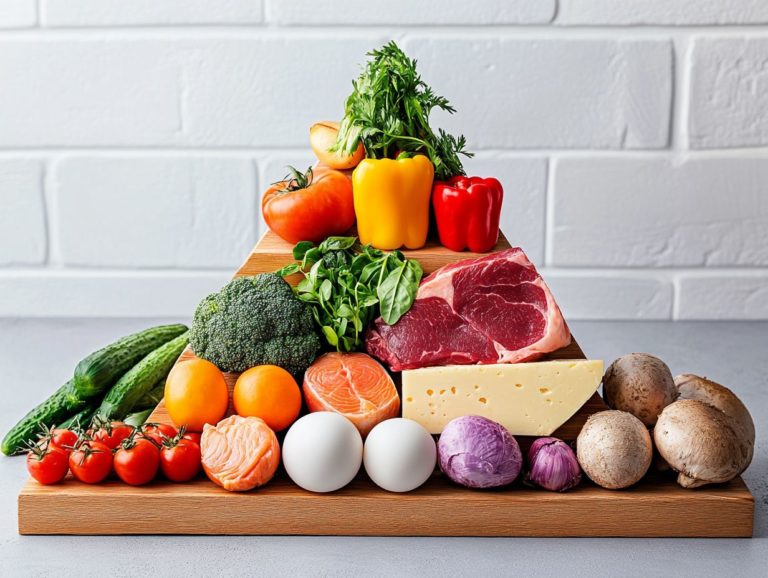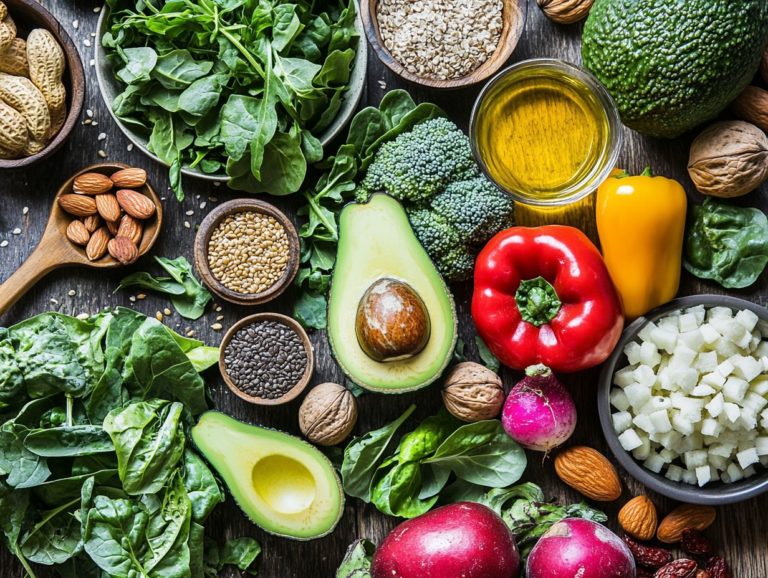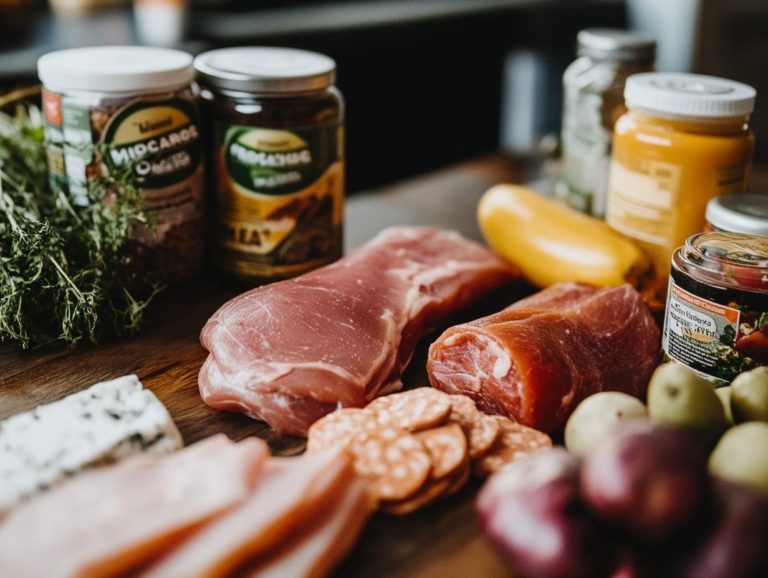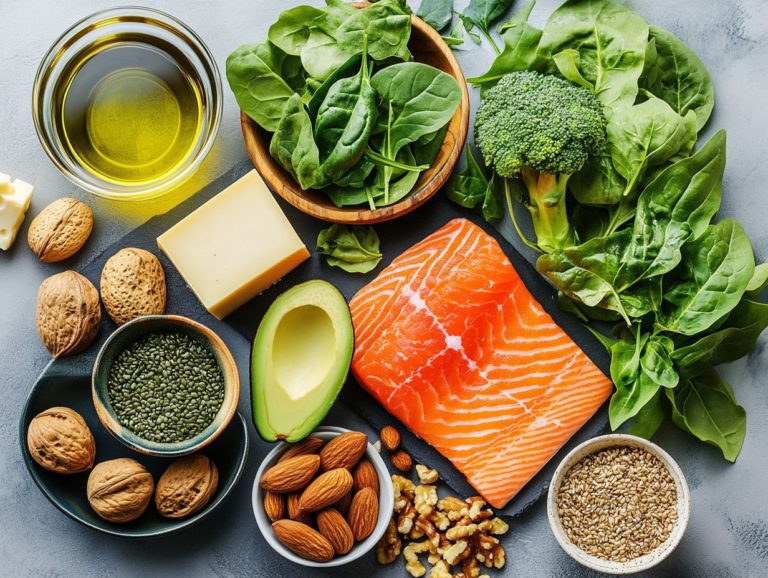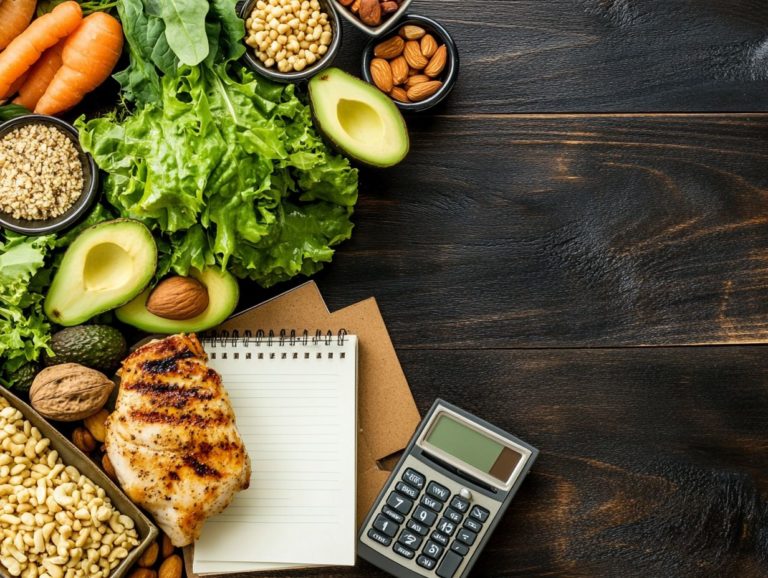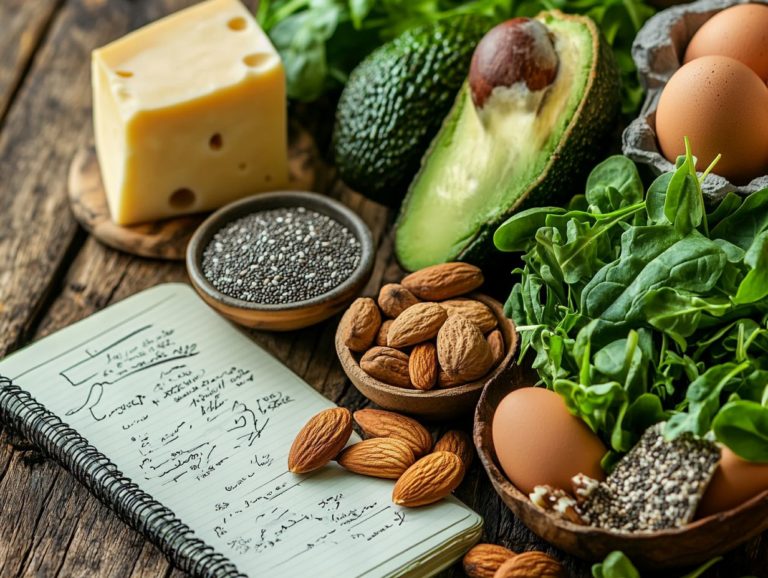Keto-Friendly Meal Plans: Nutritional Guidance
Contents
- A Comprehensive Guide to the Keto Diet
- Key Takeaways:
- What is the Keto Diet?
- What Foods are Allowed on the Keto Diet?
- 4. Dairy
- 5. Nuts and Seeds
- What Foods Should Be Avoided on the Keto Diet?
- 2. Processed Foods
- 3. Sugary Drinks
- How to Create a Keto-Friendly Meal Plan?
- Plan Your Meals Around Low-Carb Vegetables
- Incorporate Healthy Fats and Proteins
- Choose Keto-Friendly Snacks
- What Are the Benefits of Following a Keto-Friendly Meal Plan?
- 1. Weight Loss
- 2. Improved Blood Sugar Control
- 3. Increased Energy Levels
- Are There Any Risks to Following a Keto-Friendly Meal Plan?
- Frequently Asked Questions
- What is a keto-friendly meal plan?
- Are all keto-friendly meal plans the same?
- What are the benefits of following a keto-friendly meal plan?
- Can I still eat my favorite foods on a keto-friendly meal plan?
- Do I need to track my macros on a keto-friendly meal plan?
- Is a keto-friendly meal plan suitable for everyone?
A Comprehensive Guide to the Keto Diet
The Keto diet is a popular choice for those seeking a distinctive path to weight loss and overall wellness. By significantly cutting back on carbohydrates and embracing healthy fats, you encourage your body to enter a state of ketosis, where it efficiently burns fat for energy. This diet is also known for aiding in blood sugar control and metabolic health.
This guide delves into the essentials of the Keto diet, outlining the foods you can savor and those best left aside. You will learn how to craft a delicious and balanced keto meal plan while exploring the benefits and potential risks associated with adopting this lifestyle, such as nutrient deficiencies and the keto flu.
Whether you re contemplating the Keto diet or simply intrigued by its principles, this guide offers you a wealth of comprehensive information to navigate your journey. From keto diet basics to advanced meal planning tips, you will find everything needed for a successful transition.
Key Takeaways:
- The Keto diet consists of high-fat, moderate-protein, and low-carb foods, which can be planned using a comprehensive shopping list.
- To create a Keto-friendly meal plan, calculate your macronutrients, focus on low-carb vegetables, and incorporate healthy fats and proteins. Include keto-friendly snacks and beverages to keep your diet enjoyable and varied.
- Benefits of following a Keto-friendly meal plan include healthy weight loss, improved blood sugar control, increased energy levels, and reduced inflammation. However, risks include nutrient deficiencies, the “Keto flu,” and difficulty sustaining long-term.
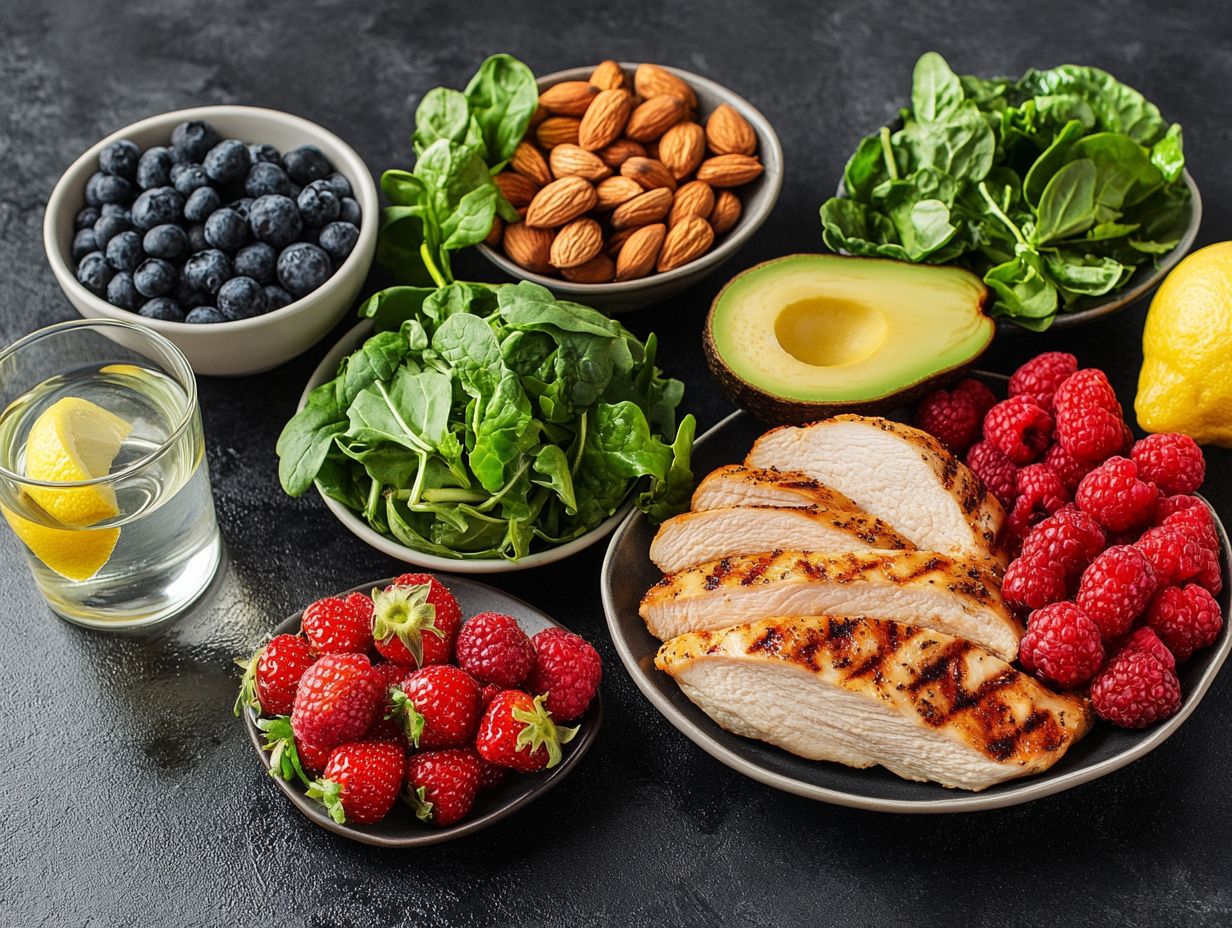
What is the Keto Diet?
The keto diet, often referred to as the ketogenic diet, is a low-carb, high-fat approach that encourages your body to enter a state known as ketosis. In this metabolic state, fat steps in as the primary source of energy instead of carbohydrates. This diet can be enhanced with intermittent fasting for greater health improvements.
Its rising popularity is attributed to various health benefits, including effective weight loss, improved blood sugar control, and alleviation of symptoms associated with type 2 diabetes. Renowned experts like Dr. Andreas Eenfeldt, Franziska Spritzler, and Dr. Bret Scher have underscored these advantages while also addressing potential challenges, such as the dreaded keto flu. They also highlight the long-term viability of maintaining such a low-carb lifestyle, particularly for those with Alzheimer s disease.
What Foods are Allowed on the Keto Diet?
On the keto diet, you re embraced by a world of keto foods rich in healthy fats and moderate in proteins, while being remarkably low in carbohydrates. These keto foods can easily be incorporated into your meal prep and keto recipes.
Your culinary journey includes a delightful selection of keto-friendly options such as creamy avocados, robust olive oil, and succulent fatty fish. You can complement these with an assortment of low-carb vegetables like vibrant leafy greens and hearty cruciferous varieties.
Dairy products like Greek yogurt and a variety of nuts and seeds fit seamlessly into your keto meal plan, ensuring you receive essential nutrients while keeping your carbohydrate intake wonderfully minimal.
Start your Keto journey today and discover the delicious possibilities!
Don’t miss out on the opportunity to transform your health with the Keto diet!
1. The Role of Fats in Keto
Fats serve as the cornerstone of your keto diet, providing the primary energy source that fuels your body during ketosis. Healthy options like olive oil, avocado, and butter are particularly recommended. These fats not only support how your body processes food but also aid in appetite suppression. This makes it easier for you to navigate your weight loss journey successfully.
By incorporating saturated fats in moderation, you can enhance the flavor and satisfaction of your meals while ensuring your keto meal plan remains effective. Diversifying your fat sources provides additional benefits. For example, coconut oil is rich in medium-chain triglycerides (MCTs), a type of fat that’s quickly used for energy, promoting a quicker transition into ketosis. Similarly, incorporating fatty fish like salmon into your diet provides omega-3 fatty acids, essential for heart health and known for their anti-inflammatory properties.
To make the most of these fats, consider saut ing your vegetables in olive oil or baking fatty fish with a generous drizzle of butter. Avocados also serve as a versatile ingredient in salads or smoothies, enhancing both flavor and nutritional value while keeping your ketosis process right on track.
2. Importance of Proteins on a Keto Diet
Proteins are absolutely essential in your keto journey, helping to maintain muscle and overall health while you keep those carbohydrates in check. High-protein keto options like chicken, fish, and eggs are not only popular but also critical for keeping you full, which aids in appetite suppression. Balancing your protein intake is key for success, as it harmonizes with your fat consumption for optimal metabolic health.
Beyond the basics of chicken, fish, and eggs, you can also incorporate a variety of protein-rich choices such as beef, pork, and plant-based sources like tofu and tempeh. Each of these proteins brings its own unique benefits. For instance, fatty fish like salmon are packed with omega-3 fatty acids, promoting heart health while seamlessly fitting into a low-carb meal.
Consider preparing dishes like creamy garlic butter shrimp or a savory egg and spinach frittata. These meals not only keep hunger at bay but also elevate the flavor profile with healthy fats. Pairing these proteins with keto-friendly fats such as avocado or coconut oil results in balanced meals that effectively fuel your body, ensuring you have steady energy levels while boosting fat-burning in your metabolic process. Effective meal planning is essential for sustaining your low-carb diet.
3. Incorporating Low-Carb Vegetables
Low-carb vegetables are a critical part of your keto journey, offering fiber and essential nutrients without significantly boosting your carbohydrate intake. This makes them perfectly suited for maintaining ketosis. Keto vegetables like leafy greens, broccoli, and cauliflower not only add volume to your meals but also enhance their nutrient density, supporting your overall metabolic health.
Plus, the rich fiber content can aid digestion and contribute to healthy weight loss. By including these vegetables in your daily meals, you can unlock a multitude of benefits, from boosting your energy levels to enhancing satiety during meals. Incorporating them into your keto recipes is a breeze; for instance, leafy greens can be the foundation of your salads or wraps, while broccoli and cauliflower make fantastic steamed or roasted side dishes.
Feel free to blend these vegetables into smoothies or use them as low-carb alternatives in comfort foods, like cauliflower rice or pizza crusts. Planning ahead with meal prep and a detailed shopping list will help ensure these nourishing components are always on hand, making it easier for you to make healthier eating choices throughout the week.
Start incorporating these delicious options into your meals today and feel the difference!
4. Dairy
Dairy products are a delicious way to enhance your keto diet. They provide healthy fats and protein while keeping carbohydrates low. Popular choices like Greek yogurt, cheese, and heavy cream not only add richness and flavor to your recipes but also help you meet your daily fat intake goals. This makes meal prep more enjoyable and satisfying.
Incorporating dairy into your meals enhances texture and flavor, creating delightful dining moments. Creamy cheeses such as mozzarella and goat cheese can be added to savory casseroles or used as toppings for keto pizzas. This allows you to satisfy your cravings while sticking to your dietary restrictions.
High-fat dairy options like sour cream and cream cheese will take your dips and spreads to the next level! A quick recipe like a cheesy broccoli bake with heavy cream and cheddar cheese shows how to blend nutrition and flavor, appealing to keto enthusiasts and anyone looking to eat healthily.
5. Nuts and Seeds
Nuts and seeds are exceptional additions to your keto meal plan. They provide a delightful mix of healthy fats, protein, and fiber while keeping carbohydrates low. They make perfect keto-friendly snacks. Varieties like almonds, walnuts, and chia seeds enhance meal textures and help with appetite suppression, supporting your journey towards healthy weight loss.
Seeds such as flaxseeds and pumpkin seeds are fantastic sources of omega-3 fatty acids and magnesium, both essential for your overall wellness. These nutrient-packed gems can be easily sprinkled on salads, blended into smoothies, or transformed into delicious energy balls.
For meal prep, try making some almond butter to dip crunchy celery sticks or mix into low-carb smoothies. Roasted nuts seasoned with spices add a satisfying crunch to any dish, delivering flavor and nutritional benefits as you navigate your keto journey.
What Foods Should Be Avoided on the Keto Diet?

To embrace the keto diet and maintain ketosis, it’s crucial to avoid foods high in carbohydrates, processed items, and those laden with sugar. These can derail your body s fat-burning processes and make it harder to maintain steady blood sugar levels, keeping you on track with your keto meal plan.
Familiar high-carb culprits include bread, pasta, and sugary beverages, which can spike your blood sugar levels and obstruct weight loss efforts. Avoiding these foods will support your progress.
Avoiding processed foods also promotes your body s health and simplifies your path to achieving long-term dietary goals.
1. High-Carb Foods
High-carb foods are the main foods to avoid on your keto journey. They can quickly elevate your carbohydrate intake and kick you out of ketosis. Grains, sugars, and certain fruits are particularly troublesome. Foods like bread, pasta, and rice not only add unnecessary carbs but can also spark cravings and interfere with the appetite-suppressing benefits of the keto diet.
Processed snacks and sugary drinks are significant sources of hidden carbohydrates that can disrupt your progress. Items such as granola bars, flavored yogurts, and certain condiments may seem healthy but are often packed with sugars and starches.
To manage your carb intake effectively, scrutinize nutrition labels carefully pay attention to total carbohydrate content as well as sugar and fiber levels. Opt for whole, unprocessed foods whenever possible, and consider meal prepping to reduce the temptation of reaching for high-carb options when hunger strikes.
2. Processed Foods
Avoid processed foods while on the keto diet. They often harbor hidden carbohydrates, unhealthy fats, and a plethora of additives that can undermine your metabolic health and the state of ketosis.
Many processed snacks, meals, and beverages are laden with preservatives and sugars, which can lead to poor blood sugar control and derail your weight loss journey.
To thrive on the ketogenic diet, be sure to read food labels carefully. For example, certain low-fat yogurts or granola bars may appear healthy at first glance, but they often contain added sugars that could easily sabotage your efforts.
Nutrition experts like Franziska Spritzler emphasize the importance of scrutinizing food labels to avoid hidden sugars. Instead, prioritize whole, natural foods such as fresh vegetables, high-quality meats, and healthy fats like olive oil and avocados.
Yogurts such as Greek yogurt can also be a healthy addition when chosen carefully. When navigating store aisles, seek out products with minimal ingredients preferably those you can actually pronounce.
Always be vigilant for hidden sugars or artificial ingredients that may disrupt your progress on this high-fat, low-carb adventure.
3. Sugary Drinks
Sugary drinks, such as soda and fruit juices, are particularly detrimental if you’re following the keto diet. They can swiftly introduce excessive carbohydrates and sugar, knocking you out of ketosis.
These beverages cause rapid spikes in blood sugar and foster heightened cravings, making it increasingly challenging to achieve and maintain healthy weight loss.
Indulging in sugary drinks can knock you out of ketosis and leave you with unreliable energy levels throughout the day.
To support your metabolic health and enhance ketosis, choose low-carb, keto-friendly beverages like sparkling water, herbal teas, or homemade electrolyte drinks.
Experts like Dr. Andreas Eenfeldt and Dr. Bret Scher recommend these alternatives to satisfy your hydration needs while aligning with ketogenic principles.
Adding flavor enhancers like lemon or a few drops of natural stevia can transform hydration into a delightful experience without jeopardizing your diet.
How to Create a Keto-Friendly Meal Plan?
Incorporating a variety of healthy foods is key to achieving a balanced and sustainable keto diet. A well-planned meal strategy ensures you get all the essential nutrients needed for optimal health.
Crafting a keto-friendly meal plan is crucial for anyone navigating the keto diet successfully. It aids in calculating your macros and ensures that your meals are balanced with healthy fats, proteins, and low-carb vegetables. For more detailed guidelines, check out keto-friendly cooking: nutritional insights.
A meticulously structured meal plan streamlines your grocery shopping experience and elevates the efficiency of your meal prep. This thoughtful approach makes it easier to maintain ketosis and achieve your health and weight loss aspirations.
1. Calculate Your Macros
The first step in crafting your keto meal plan is to calculate your macros. This means determining the right balance of fats, proteins, and carbohydrates necessary to maintain ketosis and facilitate effective weight loss.
Generally, the keto diet prioritizes high fat intake (around 70-75%), moderate protein (20-25%), and very low carbohydrates (5-10%), enabling your body to transition to burning fat for energy.
To accurately assess these ratios, utilize a variety of online calculators that consider factors like your age, gender, weight, activity level, and specific goals such as weight loss or muscle gain.
If your aim is to shed some pounds, you might start with a higher fat ratio and adjust it as you progress.
Tracking your daily intake of these macronutrients can be easily managed through apps that log your food consumption, providing a clear picture of your adherence to the plan.
It s essential to regularly evaluate the effectiveness of your chosen ratios since metabolic adaptations might necessitate adjustments over time to keep you moving toward your fitness goals.
Start your journey today and unlock the benefits of a ketogenic lifestyle!
Plan Your Meals Around Low-Carb Vegetables
Planning your meals around low-carb vegetables is crucial for crafting a successful keto meal plan. These veggies not only keep your carbohydrate intake in check but also provide essential nutrients that your body craves.
Beyond being low in carbs, these vegetables are brimming with vitamins, minerals, and antioxidants that bolster your overall health. Take spinach, for example; it s loaded with iron and magnesium, while zucchini delivers a healthy dose of vitamin C. You can easily incorporate these nutritious powerhouses into your meal plan by trying out recipes like a spinach and feta omelet for breakfast or a zesty zucchini noodle pasta for dinner.
To keep these vegetables fresh and flavorful, consider blanching them before freezing or storing them in airtight containers to maintain their crispness. This way, you’ll always be ready to whip up delicious meals in no time, ensuring your low-carb diet remains vibrant and varied.
Incorporate Healthy Fats and Proteins
Incorporating healthy fats and proteins into your keto meal plan is essential for achieving the right balance of fats, proteins, and carbs while keeping your meals both satisfying and nutritious. By choosing sources of healthy fats like olive oil and avocado and pairing them with high-quality proteins such as fish and poultry, you ll love how these meals keep you full and satisfied!
Consider cooking methods like grilling, which beautifully captures the natural flavors of your proteins, or roasting vegetables in olive oil to enhance their sweetness. Imagine combining ingredients like salmon with a rich, creamy avocado sauce or preparing chicken thighs infused with garlic and herbs both options enhance the nutritional value and tantalize your taste buds.
Here are some meal ideas to inspire you:
- A vibrant spinach salad topped with crunchy walnuts and tangy feta
- Grilled shrimp skewers brushed with a refreshing lime dressing
- A hearty breakfast featuring scrambled eggs cooked in butter, served with saut ed spinach and melted cheese
These combinations not only keep your meals exciting but also ensure you’re reaping the full benefits of healthy fats and high-quality protein.
Choose Keto-Friendly Snacks
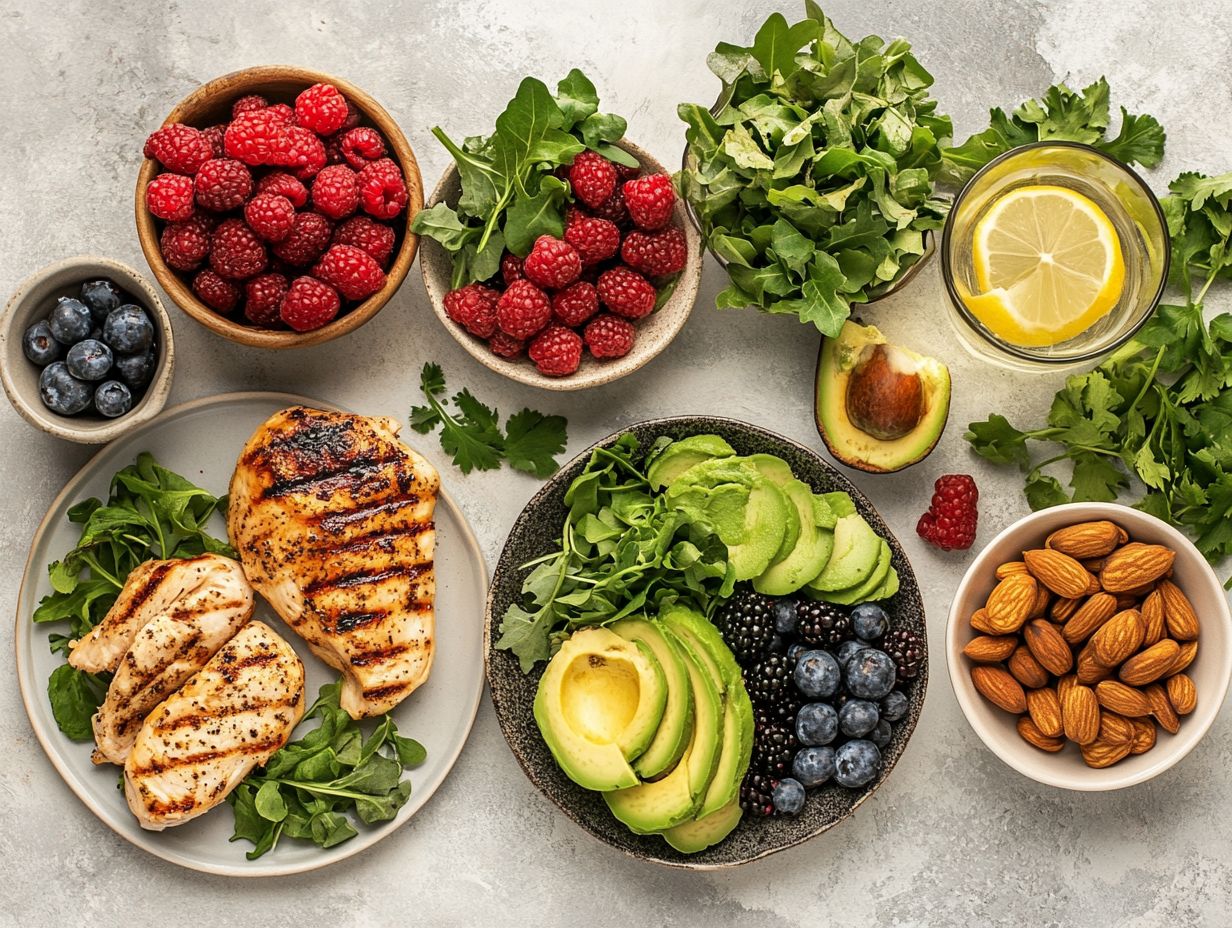
Choosing keto-friendly snacks is a vital strategy for managing hunger and maintaining energy levels throughout the day without breaching your carbohydrate limits. These snacks are not just an afterthought; they’re a valuable addition to your keto meal plan. Options like nuts, cheese, and low-carb protein bars can deliver that satisfying crunch or creamy texture you crave, effectively curbing your cravings while supporting healthy weight loss.
Plus those, think about incorporating fresh vegetables like cucumber and bell peppers, paired with cream cheese or guacamole. They offer a refreshing burst of flavor that can elevate your snack game. For a quick fix, consider whipping up some keto fat bombs simple mixtures of cream cheese, nut butter, and unsweetened cocoa powder that you can stash in the freezer for easy access.
Integrating these snacks into your daily routine can be effortless. Set aside a little time each week for snack prep, ensuring you have convenient options ready for those busy days. And don t forget about portion control using small containers or bags can help you manage quantities and stay on track with your keto guidelines.
What Are the Benefits of Following a Keto-Friendly Meal Plan?
Adopting a keto-friendly meal plan can also provide protective benefits against neurodegenerative diseases such as Alzheimer s disease. The diet’s focus on healthy fats and low carbohydrates can support brain health.
Embracing a keto-friendly meal plan presents a wealth of benefits that can transform your health journey. You can expect effective weight loss, improved blood sugar control, heightened energy levels, and reduced inflammation.
This approach is not just about cutting carbs; it s a holistic pathway to better health. Numerous studies, including those by Dr. Andreas Eenfeldt, indicate that individuals who adopt this low-carb lifestyle often experience remarkable health improvements, aiding not only in fat loss but also fostering metabolic health and enhancing overall well-being.
In summary, planning your meals, incorporating healthy fats and proteins, and choosing the right snacks can make your keto journey enjoyable and effective. Start planning your own keto meal plan today or try out the recipes mentioned!
1. Weight Loss
A keto-friendly meal plan is remarkably effective for weight loss. It helps suppress your appetite and enhances fat burning by putting your body in ketosis.
Ketosis is a fascinating energy state where your body shifts from using glucose to burning fat, which results in the production of ketones. This process accelerates fat loss while helping you maintain muscle mass an essential aspect of any successful weight loss journey.
To keep your motivation high throughout this process, set realistic goals and celebrate small victories along the way. Tracking your progress through meal journaling and monitoring weight fluctuations allows you to visualize advancements, making it easier to adjust as needed.
Connecting with a supportive community reinforces your commitment and provides valuable resources to help you navigate challenges. Regularly revisiting the reasons for starting this diet can reignite your motivation and remind you of the long-term health benefits that await.
2. Improved Blood Sugar Control
A keto-friendly meal plan helps improve blood sugar control, especially for those with type 2 diabetes. By stabilizing insulin levels and minimizing spikes in blood sugar, you support metabolic health and reduce the risk of diabetes-related complications, ultimately enhancing your quality of life.
Research suggests that a ketogenic diet can coax your body into ketosis, where fat becomes the primary energy source instead of carbohydrates. This dietary shift lowers circulating blood glucose and insulin levels, which are crucial for managing diabetes effectively.
Numerous studies have highlighted participants on a keto diet who experienced significant reductions in hemoglobin A1c levels, indicating better long-term blood sugar control. Anecdotal evidence from individuals with type 2 diabetes reveals that embracing this low-carb lifestyle often leads to increased energy levels and reduced cravings, fostering an overall sense of well-being.
3. Increased Energy Levels
Many individuals on a keto meal plan experience a notable boost in energy levels. This is due to the body’s ability to use fat as fuel during ketosis.
As you adapt to burning fat rather than carbohydrates for energy, you may notice a significant enhancement in overall stamina and a reduction in fatigue. This shift makes daily activities and exercise feel more manageable.
This transition from carbohydrate to fat metabolism profoundly influences your daily energy. Unlike carbohydrates, which can cause energy spikes followed by crashes, fat provides a more stable energy source.
For example, one fitness enthusiast shared how after embracing a low-carb diet, her workouts felt less draining, allowing her to extend training sessions without experiencing a post-workout slump. Incorporating foods like Greek yogurt provides protein and probiotics, further supporting energy levels and overall health.
Another individual mentioned that their mid-afternoon energy crashes disappeared, enabling them to stay productive without resorting to sugary snacks. These personal anecdotes highlight the compelling advantages of fat metabolism, enhancing energy consistency and overall vitality in a transformative way.
Ready to explore the benefits of a keto meal plan? Start your journey today and see how it can transform your health and well-being!
4. Reducing Inflammation
Following a keto-friendly meal plan can significantly reduce inflammation, which in turn can profoundly impact your metabolic health and lower your risk of chronic diseases. The low-carb, high-fat nature of the diet is believed to decrease inflammatory markers in your body, leading to better overall health outcomes.
This change can contribute to an enhanced sense of well-being. Research indicates that many chronic diseases, including heart disease, diabetes, Alzheimer s disease, and certain types of cancer, are worsened by persistent inflammation. By shifting your body s metabolism toward ketosis, which is when your body uses fat instead of carbs for energy, the keto diet encourages the use of fat for energy, resulting in lower insulin levels and a reduction in inflammatory responses.
As you commit to this dietary approach, you may discover that you not only manage your symptoms more effectively but also take a proactive step toward preventing chronic conditions! This can enhance your quality of life and promote longevity, allowing you to thrive in a healthier, more vibrant state.
Are There Any Risks to Following a Keto-Friendly Meal Plan?
While a keto-friendly meal plan presents a multitude of benefits, it s essential for you to weigh the potential risks that accompany its implementation. These risks include nutrient deficiencies, the infamous keto flu, and the challenges of maintaining the diet over the long haul.
As you transition to a low-carb lifestyle, you may notice some temporary symptoms that can catch you off guard! These initial symptoms like fatigue, headaches, and irritability collectively known as the keto flu can be quite concerning, especially for those new to the lifestyle.
1. Nutrient Deficiencies
One of the potential risks of adopting a keto-friendly meal plan is the chance of facing nutrient deficiencies, especially if you don t meticulously plan your meals to include a diverse array of vitamins and minerals. With many fruits, grains, and legumes off the table, it becomes crucial for you to focus on incorporating nutrient-dense foods that will meet your dietary needs and stave off deficiencies.
For instance, you might discover that you’re missing out on essential nutrients like magnesium, potassium, and fiber. To address this, consider adding leafy greens like spinach and kale to your meals, as they are rich in magnesium. Avocados provide an excellent source of potassium and healthy fats.
In terms of fiber, exploring options such as chia seeds and flaxseeds can significantly support your digestive health. Considering a high-quality supplement can help bridge any gaps in your nutrient intake, ensuring that your meal plan remains balanced and healthy overall.
2. Keto Flu
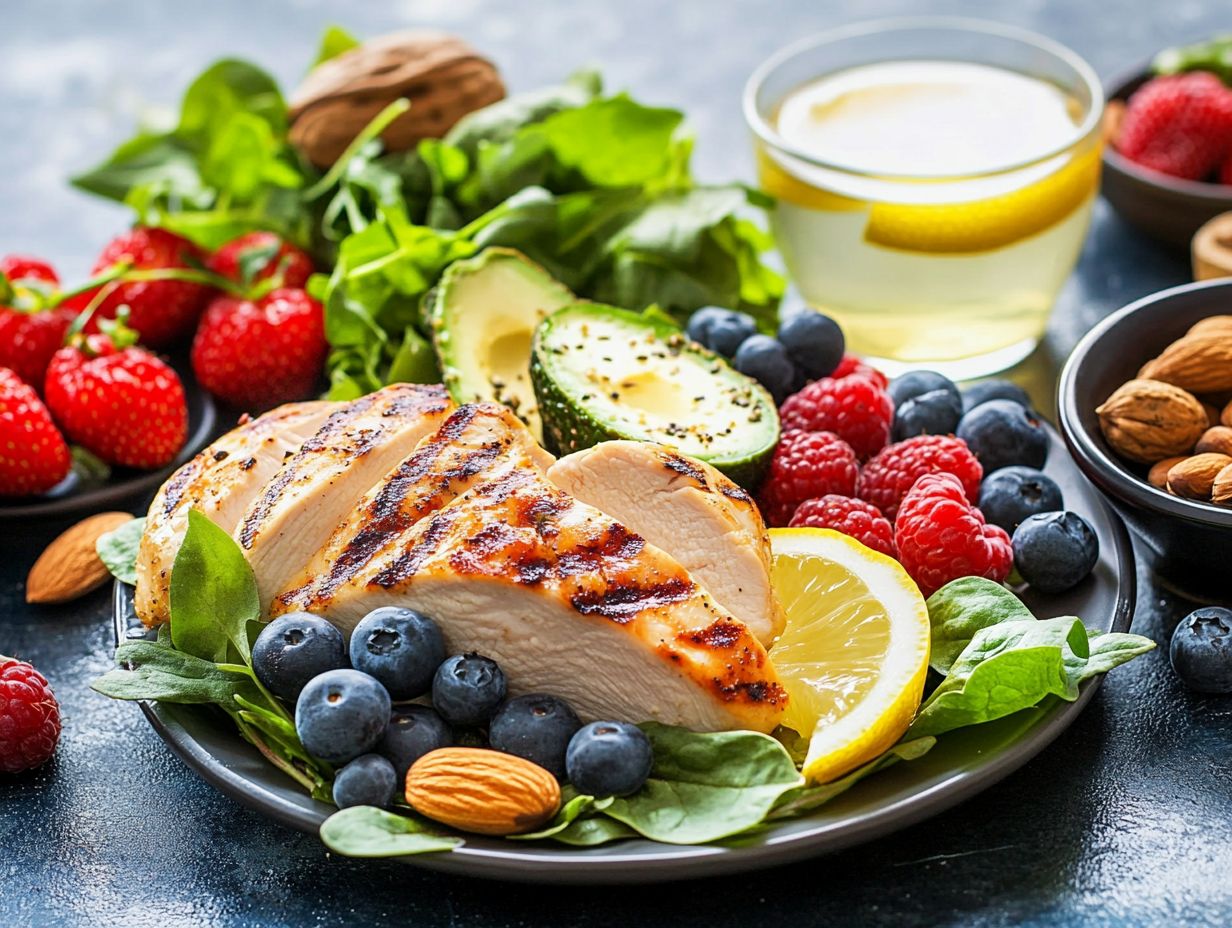
Keto flu refers to those flu-like symptoms you might encounter when transitioning to a keto-friendly meal plan. You could experience fatigue, headaches, and irritability as your body shifts from burning carbohydrates to relying on fat for fuel. This adjustment period can undoubtedly be disorienting, especially for those new to the diet.
During this phase, which can last anywhere from a few days to a couple of weeks, you might also notice symptoms like nausea, muscle cramps, and mental fog. To ease your transition and minimize discomfort, it s crucial to stay well-hydrated, as electrolyte imbalances can amplify those pesky symptoms.
Incorporating high-sodium foods such as bone broth and leafy greens will help replenish essential electrolytes. Rather than making a sudden switch, consider gradually reducing your carbohydrate intake to facilitate a smoother adaptation. Prioritizing rest and engaging in light physical activity can also support your body as it adjusts to this new way of eating.
3. Difficulty Sustaining Long-Term
Many individuals often struggle to maintain a keto-friendly meal plan in the long run due to pesky cravings for carbohydrates and the strict nature of the diet. This challenge can create a sense of deprivation, hindering lasting lifestyle changes that promote healthy eating habits.
To successfully transition into a sustainable keto lifestyle, you can adopt strategies that emphasize balance and flexibility. Incorporating occasional carb refeed days is an effective approach that can satisfy your cravings while keeping you aligned with your overall dietary goals. Gradually adjusting your habits to embrace keto principles in a more relaxed way can foster a way of eating that feels attainable.
This might involve exploring a variety of food options that adhere to keto guidelines or learning to enjoy your meals without being overly restrictive. Ultimately, finding your personal rhythm that accommodates cravings while still prioritizing your health can significantly enhance your experience on the keto journey.
Frequently Asked Questions
What is a keto-friendly meal plan?
A keto-friendly meal plan focuses on consuming low-carb, high-fat foods. This type of diet aims to put the body into a state of ketosis, where it burns fat for energy instead of carbohydrates. Experts like Dr. Andreas Eenfeldt and Franziska Spritzler advocate for the benefits of this diet.
Are all keto-friendly meal plans the same?
No, there are many variations of keto-friendly meal plans. Some may include more dairy and protein, like Greek yogurt, while others may be more plant-based. It is important to find a plan that works best for your body and fits your lifestyle.
What are the benefits of following a keto-friendly meal plan?
Some potential benefits of following a keto-friendly meal plan include weight loss, improved energy levels, and better blood sugar management. It may also positively impact conditions such as epilepsy, PCOS, and potentially even Alzheimer s disease.
Can I still eat my favorite foods on a keto-friendly meal plan?
It depends on the specific foods and ingredients. While some foods may need to be eliminated, there are usually keto-friendly alternatives available. Planning and ensuring your meals are balanced and nutrient-dense is essential.
Do I need to track my macros on a keto-friendly meal plan?
Tracking macros, or macronutrients, isn’t necessary on a keto-friendly meal plan, but it can be helpful to ensure you consume the right amount of fat, protein, and carbs to maintain a state of ketosis. Consulting with a keto expert like Dr. Bret Scher can provide further guidance on this.
Is a keto-friendly meal plan suitable for everyone?
A keto-friendly meal plan may not be suitable for everyone. It’s always important to consult with a healthcare professional before starting any new diet. People with specific medical conditions, such as kidney disease, may need to modify or avoid a keto-friendly diet. Expert opinions from physicians like Dr. Andreas Eenfeldt or Dr. Bret Scher can be invaluable.

